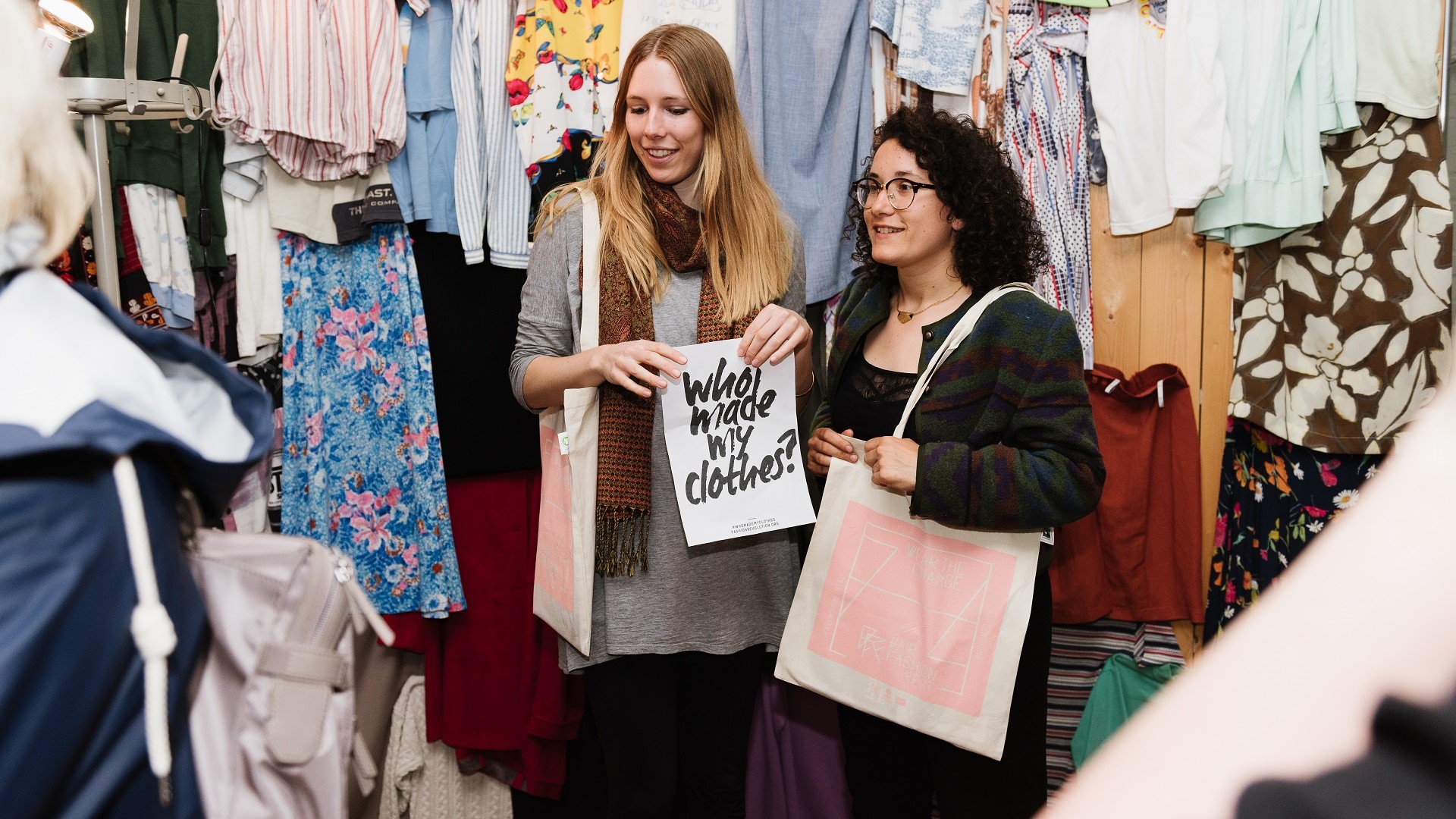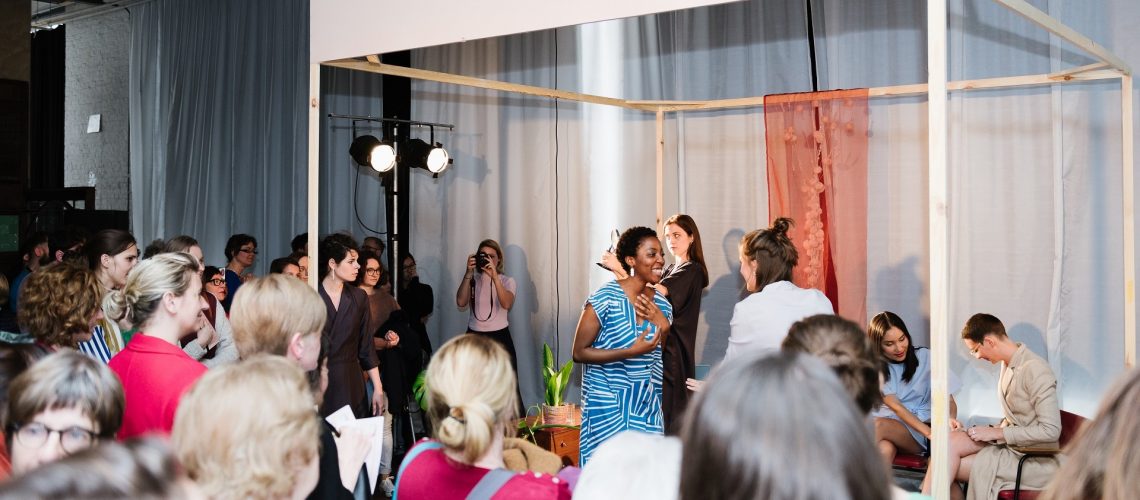From fair trade coffee to fair fashion
For many years the Fair Trade Towns campaign has shown that local authorities can play an important role in promoting fair and sustainable trade. In Belgium’s Flemish region no less than 198 municipalities have become Fair Trade Towns, Wallonia and Brussels have 41 ‘Communes du commerce équitable’. Since Luxembourg joined, no less than 5 of Belgium’s 10 provinces also carry the honorary title. However, once the basic criteria have been met, what’s next? What if your local council buys fair trade coffee and juices, local organisations, schools and shops have joined and local and sustainable products are promoted?
Is that the end of it? No. The city of Ghent has proven you can go further. A long road lies between 2005, when Ghent was the first Belgian city to pride itself with the ‘FairTradeGemeente’ title, and 2018, when it obtained the first European Cities for Fair and Ethical Trade Award. “A road we want to continue even further on,” guaranteed newly-installed mayor Mathias De Clercq recently during a symposium on sustainable cocoa. “We don’t sit back and relax. Instead, we make fair trade the cutting edge of our international policy.”
To find out how Ghent does this, we visited Tine Heyse, alderwoman for North-South affairs, Christophe Ramont, of the city’s International Relations Service and Jonathan Janssens, coordinator of Ghent Fair Trade.
From Fair Trade Town to Fair Trade Capital
“In 2012, at the onset of the previous policy term, we considered how to scale up what the city had done until then on fair trade,” begins Tine. “We soon decided to work with fair textiles as a theme offering potential. First of all, because we really wanted to open up a new segment and secondly, because textiles are a very logical choice for Ghent. If people have forgotten how badly labour conditions in the textile industry can impact a city, they can always visit our historical museums. Textile is in our city’s DNA. The disaster in the Rana Plaza garment factory in Bangladesh in 2013 also springs to mind. This led to a major call for action and alternatives.”

The people behind the Fair Trade Town project, most of which volunteered at the local fair trade world shop, were logically involved. Ghent Fair Trade was established, a collaboration between the City of Ghent and Oxfam-Wereldwinkels shops of the area. “From the onset ‘fair trade in good company’ was our baseline,” emphasises Jonathan. “There was an obvious open-door policy and we were constantly looking for new partners. The textile topic was perfect for the purpose.”
Traditionally, the month of March is Belmundo month in Ghent. It is a festival that offers a broad range of activities of North-South organisations and the City. In 2015, Ghent Fair Trade planned a Fair Fashion Fest in the margins of the festival, offering a mix of workshops, debates and fashion shows with fair trade alternatives. “We had hoped for 500 visitors, but three times as many showed up,” remembers Jonathan. “Obviously, we had attracted a new crowd: people who were not necessarily into fair trade but who still shared the public outcry surrounding Rana Plaza and wanted to purchase clothes consciously.”
“The first Fair Fashion Fest strengthened us in the challenge we had set for ourselves with Ghent Fair Trade,” continues Tine. “More people from Ghent – or visitors to Ghent – had to find more fair and sustainable clothes in more shops in our city. It became clear we had to pursue the three approaches further: first of all, promote the offer and therefore back the products and shops, secondly, foster demand and therefore convince more consumers and finally, lead by example through our City procurement policy.”
Approach 1: More fair trade products in Ghent
4,000 visitors came to Fair is the new black, the second edition, and Wear The Change, the third edition of the Fair Fashion Fest. “Some 25 people were involved in organising the very first edition,” Jonathan remembers. “Designers, shopkeepers, start-ups and volunteers. The offer of fair garments was limited but the foundations for more actions had been laid. Meanwhile, we have a platform of some 50, mostly young entrepreneurs. During Fair Fashion Talks we listen to experts, discuss issues and prepare the next Fair Fashion Fest. As a city we cannot give them subsidies but we can provide a forum for their stories.”
These pioneers are now showcased in a Fair Boutique & Vintage Walk, a Fair Fashion Walk and a Fair Food Walk. The Ghent Fair Trade website meanwhile shows 75 ‘hotspots’ for fans of fair. It is about more than just fashion. Restaurants and pubs have to offer at least three fair trade products to get listed. But there are also flower shops, jewellers, decoration and cosmetics shops. “Every week there is a new initiative that wants to be on the list,” adds Jonathan. “The criteria cannot always be that sharp. It may regard labels, like for fair trade gold. The flower shops offer organic, locally-grown flowers. For clothes we adhere to the Clean Clothes Campaign and labour conditions, ecology and transparency criteria. We also had a study conducted into inventory labels and other sustainable initiatives in the garment industry. Sometimes I respond to entrepreneurs by asking them: Who is making your products? Where? Under what conditions? Understanding your own value chain is always a first essential step.”
#whomademyclothes
What was the matter with clothes again? In 1978, 33 % of household expenditure still went to clothing. Sturdy clothes, which could stand wear and tear and were produced in our own country. Today, garments are globalised products, stitched where wages are lowest and union trades are barred. The value chain is extremely complex and has many links, with the seamstress at the bottom of the chain losing out. And most importantly, the value chain is not transparent at all. That is why fair fashion like other fair trade approaches must advocate fair prices but also human rights, the right to education, living incomes, etc.
(Sara Ceustermans, Clean Clothes Campaign, during a Fair Fashion Talk for the Ghent platform; reported by Fei Lauw)

Have a look at your wardrobe and take stock of what you have. Check whether you know the story behind your clothes. Go for less, stop buying stuff and choose fair & second hand. Join the Fashion Revolution, an online action of ordinary people asking major fashion brands to disclose who made their clothes. Why? Because it makes brands understand that consumers do care about the story behind their clothes.
(gentfairtrade.be)
Approach 2: More conscious consumers in Ghent
Giving young entrepreneurs an opportunity only makes sense if the growing offer meets a growing demand of course. Ghent Fair Trade also tries to play a role in this matter. “It is important that we have always promoted a positive story,” emphasises Jonathan. “We keep away from the consumers’ bias. We want to show them the way to alternatives.” This not only resulted in showing the Ghent hotspots on the website, but also in publications such as Slow Fashion Forward, which is full of tips about Fair Fashion brands that you can find in Ghent. The fashion walks that bring interested groups to ethical designers fall under this approach too.

Every edition of the Fair Fashion Fest outdid the preceding one. Part of the explanation is the enthusiasm of bloggers, vloggers and influencers. “Classical fair trade communication was one-way to customers and sympathisers,” explains Jonathan. “We are very pleased to notice that the fashion world is different. With each Fair Fashion Fest, local campaigns were organised in shops and on social media. Interaction with activist followers was significant and the hashtags easily found their way on the internet. Sadly, few influencers work on fair food.”
Approach 3: sustainable city procurement
Christophe explains: “This story is one of ‘Leading by example’, which is not as easy as it seems though. “Fortunately, in Ghent an important prerequisite has been met for many years: the collaboration between the North-South and environmental services and the procurement colleagues has been good. Ghent started on the pathway of sustainable procurement a long time ago, even before the Fair Trade Towns initiative promoted the idea of sustainable procurement. Fair trade coffee has been around for more than 20 years. But procuring fair working clothes for city staff was a different challenge.” Tine laughs when she remembers: “Before I became an alderwoman, I thought it would be a matter of just entering a few criteria in the procurement procedure.” “But doing so, you risk ending up with a green-washing provider or without any clothes at all. None of which was an option, so we had to actually prepare the market. That is why we started a long itinerary, in collaboration with the Association of Flemish Cities and Municipalities (VVSG).”

Christophe takes stock of the current situation: “Last year some major contracts were awarded to five suppliers.” “Everyone was welcome, even if you had little experience with sustainable criteria. It was important to split the contract in lots. For instance, lot 1 covered work trousers, T-shirts or sweaters so we could request organic cotton or recycled polyester. In that segment we demand excellence in sustainability. But for other lots no social sustainability labels or management systems were available on the market. So, in this first stage we primarily targeted transparency. We expect suppliers – and we stipulated this in our procurement documents – to annually report on the progress they make in disentangling their supply chain. A lack of reporting can be a ground for terminating the contract. A safety shoe, for instance, has some 200 components. So, it may take a while before a supply chain becomes socially responsible. We are willing to give this time to our suppliers. And we have actually been pleasantly surprised by their level of engagement. You notice that the sector is increasingly aware of the growing pressure of consumers and municipalities.”
The VVSG and the City of Ghent have jointly published a Toolbox Socially Responsible Work Clothes, which targets procurement services of public bodies, hospitals, the police etc. We also share our experiences with other major procurers in the city which face similar questions, such as Ghent University for instance.
There is no one-fits-all answer. The 2015 paving brick discussion that raged in Ghent is an example in case. There was quite some commotion when it became known that the Indian natural bricks used for refurbishing our historic ‘Korenmarkt’ came from a region that is famous for massive labour rights breaches, including child labour. Tine: “We invited a number of specialists but they were unable to provide a final solution. There is no independent label for fair bricks, and the debate is complicated. What should you do? Only procure European bricks, as we did in some of our contracts? They are more expensive. But the question is broader one. Excluding India also means nothing will actually change for the better there.”
Pursue the same path
“Fair trade still spearheads our international solidarity policy. Ghent is historically a textile city and that is why we continue to promote fair trade textiles among inhabitants and local shops. We try to make the Ghent Group sustainable. We also investigate how other sectors can make their procurement sustainable.” This is a quote from the Ghent City Council agreements which is clear testimony to the city’s desire to pursue the same path and not to stop after having been awarded the European Fair trade capital nomination. Textiles are still key and the fourth edition of the Fair Fashion Fest is planned for 2020. The City aims to engage another sector with a project similar to the work clothes one: IT and electronics.
The alderwoman also wants to further target awareness-raising on fair and sustainable food. ‘Ghent en garde’, the project that designs a sustainable food strategy for Ghent, tries to combine local and international sustainability. Past initiatives such as a Fair Food Fest and new initiatives such as a Fair Food Walk combine aspects such as health, affordability and organic and fair trade. “I have participated in many debates and I have the impression that we are starting to get over the short chain versus fair trade dilemma. The classic saying goes: no to apples from New Zealand, even if they are fair trade. Yes, to fair trade bananas. There is an underlying ideal pursuing regional production and reconciling the economy, development and ecology.”
The European award is a nice recognition, but there is still much – fascinating ! – work ahead. The three agree on that.


